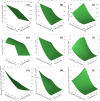Optimizing Ethanol-Water Cosolvent Systems for Green Supercritical Carbon Dioxide Extraction of Muscadine Grape Pomace Polyphenols
- PMID: 39959095
- PMCID: PMC11822697
- DOI: 10.1021/acsomega.4c10115
Optimizing Ethanol-Water Cosolvent Systems for Green Supercritical Carbon Dioxide Extraction of Muscadine Grape Pomace Polyphenols
Abstract
This study evaluated the ethanol-water modified (50%, v/v) supercritical carbon dioxide (SC-CO2) for the extraction of polyphenols from muscadine grape (Vitis rotundifolia Michgx.) pomace and compared with conventional solvent extractions (ethanol-water and HCl-methanol). The process was optimized with a central composite response surface design consisting of three levels of three independent variables: pressure (20-40 MPa), temperature (40-60 °C), and cosolvent concentration (5-15%) to maximize three responses: total phenolic content (TPC), total flavonoid content (TFC), and resveratrol yields. The optimal conditions were determined as 20 MPa, 60 °C, and 15% cosolvent concentration with TPC, TFC, and resveratrol yields of 2491 mg/100 g, 674 mg/100 g, and 1.07 mg/100 g, respectively. The surface plots indicated that a 15% cosolvent concentration maximized extraction efficiency, producing red-brown colored extracts. In contrast, a 5% cosolvent resulted in poor extractions, yielding yellow-green extracts under all conditions. The yields increased with higher temperatures (i.e., 60 °C) and lower pressures (i.e., 20 MPa). TPC and TFC obtained through cosolvent-modified SC-CO2 were similar to those obtained through conventional extractions. Moreover, the resveratrol yield was lower than the HCl-methanol extraction, even though it was not different from any ethanol-water extractions at any solvent-to-solute ratios. The analysis of antioxidants indicated that the ABTS values of the cosolvent-modified SC-CO2 extract were lower than those of the HCl-methanol extract. However, there were no significant differences in the DPPH values between the two extracts. Thus, this study optimized the sustainable technology of SC-CO2 extraction by employing only food-grade cosolvents-ethanol and water-as a more environmentally friendly method for isolating polyphenols from the underutilized waste product of muscadine grape pomace utilizing statistical methodologies in the extraction process.
© 2025 The Authors. Published by American Chemical Society.
Conflict of interest statement
The authors declare no competing financial interest.
Figures


References
-
- FAO . Crops and livestock products. Production of Grapes: top 10 producers. https://www.fao.org/faostat/en/#data/QCL/visualize (accessed September 2023).
-
- Stanislawski D. Dionysus westward: Early religion and the economic geography of wine. Geogr. Rev. 1975, 65, 427–444. 10.2307/213743. - DOI
-
- OIV . International Organization of Vine and Wine. World Statistics. https://www.oiv.int/what-we-do/global-report?oiv.
-
- Vashisth T.; Singh R. K.; Pegg R. B. Effects of drying on the phenolics content and antioxidant activity of muscadine pomace. LWT. 2011, 44 (7), 1649–1657. 10.1016/j.lwt.2011.02.011. - DOI
-
- Alonso A. D. Promotional efforts of muscadine wines and muscadine-related products: The case of southern United States wineries. Int. J. Consum. Stud. 2012, 36 (6), 702–709. 10.1111/j.1470-6431.2011.01056.x. - DOI
LinkOut - more resources
Full Text Sources
